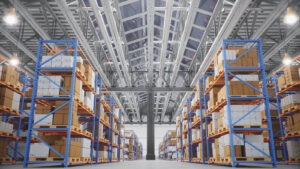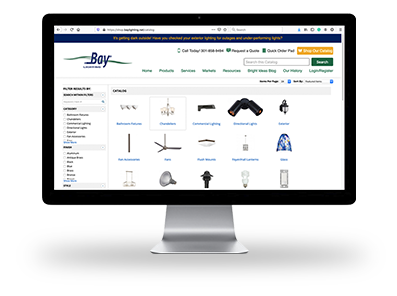Blog
- Home
- Resources
- Bright Ideas Blog
- The Importance of Using Good Warehouse Lighting
The Importance of Using Good Warehouse Lighting

Why is Warehouse Lighting Important?
Warehouses are somewhat unique when it comes to commercial lighting. They are often large buildings, lit by hard-to-reach fixtures, and may hold hundreds of workers and thousands of pieces of inventory and equipment. This level of foot traffic, not to mention operation of dangerous machinery and logistical equipment, requires optimal lighting for the prevention of injuries, mistakes, and accidents. Read on for more on the importance of efficient warehouse lighting.
Challenges Associated with Warehouse Lighting
A poorly arranged lighting installation can cause a drain on energy. Fixtures may be placed and installed in a way that causes light to be directed improperly. Things like racking and shelving must be considered before lighting is installed, which if often not the case, especially in older warehouses. Poor design can also make it hard for workers to read labels, find products, and operate machinery without experiencing high levels of glare. This is extremely dangerous to workers and inventory, so properly placed lighting is absolutely key in any warehouse. Color rendering index (CRI) must also be considered to ensure workers can see clearly throughout the entire property. A general rule of thumb is to avoid warehouse lighting systems with CRI ratings of less than 85.
Many warehouses operate 24/7, and must, therefore, be outfitted with the most efficient and long-lasting lighting possible. Otherwise, lights will burn out quickly and require a lot of costly maintenance and frequent replacement. The lifespan of LED warehouse lighting is around 50,000 hours, which, with around-the-clock operation, equates to about seven years. LEDs can be paired with a variety of features in order to promote longevity and reduce waste while lights are not needed. An LED lighting system is a great way for large properties, such as warehouses, to properly illuminate their entire buildings while simultaneously reducing energy waste and keeping costs down.
OSHA Lighting Requirements for Warehouses
Warehouses are often spaces where dangerous machinery is operated daily. Accordingly, the Occupational Safety and Health Administration (OSHA) has issued specific requirements for warehouse lighting. These requirements are intended to keep workers safe from accident and injury due to the inability to see properly. Two terms to keep in mind when talking about proper lighting for this application – lux and lumens. The amount of light cast on a surface is termed illuminance and is measured in lux. Lumens is the total output of visible light from a light source. In warehouses, OSHA requires the following:
- A minimum of 2 lumens per square foot in areas with heavy equipment use
- 300-400 lux for warehouse loading bays
- 100-200 lux for warehouse aisles
- 200 lux for lobbies, stairwells, and corridors
- 750 lux for factories and workshops
- 500 lux for laboratories, offices, and showrooms
OSHA also requires the following safety standards in regard to lighting fixtures:
- No exposed live parts
- Firm mounting to walls
- No openings large enough for a finger to fit through
- Placement at least 7 feet above work surfaces or an OSHA-compliant shatter-proof shield
Warehouses and other commercial businesses that do not comply with OSHA run the risk of receiving numerous fines so it’s always best practice to research OSHA guidelines for your industry.
In the event of an emergency, lighting can be a critical part of preventing injury or even saving lives. OSHA recommends compliance with the National Fire Protection Agency’s guidance around emergency lighting, which includes the following:
- All exit signs must be properly lit so that employees with normal vision can see along the exit routes
- Each exit must be marked with a sign reading “exit”
- Exit signs must be clearly visible for 90 minutes in a power outage/when lights go out
- Emergency lighting must provide no less than 10.8 lux illumination along the exit route
- Emergency lighting must be tested for brightness and battery life every 30 days
- Functional testing of emergency lighting must be conducted annually for no less than 1.5 hours if the system is battery-powered
The Americans with Disabilities Act also lays out a number of safety guidelines in public places, for which there are also fines for non-compliance. It is important to work with a lighting professional when installing your warehouse lights. A professional can help ensure your warehouse lighting is in compliance with OSHA and following relevant guidance to ensure your space is safe for workers at all times.
Energy Savings and Warehouse Lighting
According to a study conducted by Georgia Power, lighting is the largest energy expense in a warehouse. A major way warehouse owners and managers can cut down on energy expenses is by upgrading their commercial lighting fixtures with the assistance of a lighting professional. Many warehouses contain outdated, fluorescent high bays, metal halides, and other fixtures that keep energy costs high due to things like high switching rates and high maintenance costs. LED technology makes it easier to install long-lasting fixtures that do not need to be replaced frequently and provide high-quality lumen output. In fact, upgrading to LED fixtures has been known to generate savings for warehouses of approximately 61%. Adding compatible motion sensors and other features can save up to 70% more energy in the long term, and your lighting service can help match you with energy-focused rebates from local utility companies. Upgrading warehouse lighting is a smart choice for anyone looking to reduce their emissions and save on energy expenses.
Recommended Warehouse Lighting
Warehouses have specific requirements when it comes to lighting. Products like LED linear lamps, LED high bay fixtures, LED emergency lights and exit signs, can update any warehouse and make it a safer and more efficient work environment. Control systems, such as timers and dimmers, are also recommended, especially in warehouses that operate 24/7. A lighting technician can help choose the best lighting fixtures for your specific commercial space. Warehouse lighting must be selected with worker safety, lifespan, and quality in mind. Examples of recommended warehouse lighting products include:
- Linear High Bay LED Warehouse Ceiling Lights
- LED Low Bay Warehouse Ceiling Lights
- LED UFO High Bay Lights
- High Bay LED Vapor Tight Warehouse Light Fixtures
- LED Emergency Combo Lighting
Contact Us
If you are interested in upgrading your warehouse lighting, contact Bay Lighting today. We equip warehouses in Maryland, D.C., and Virginia with state-of-the-art lighting solutions that improve safety conditions and overall efficiency. Call 301-858-9494 to get started.




